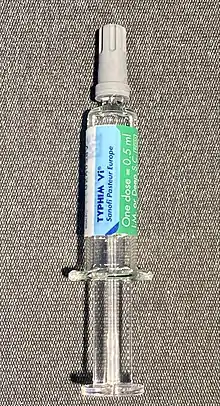Typhoid vaccine
Typhoid vaccines are vaccines that prevent typhoid fever.[1][2] Several types are widely available: typhoid conjugate vaccine (TCV), Ty21a (a live oral vaccine) and Vi capsular polysaccharide vaccine (ViPS) (an injectable subunit vaccine). They are about 30 to 70% effective in the first two years, depending on the specific vaccine in question. The Vi-rEPA vaccine has been shown to be efficacious in children.[3]
 | |
| Vaccine description | |
|---|---|
| Target | Typhoid |
| Clinical data | |
| Trade names | Typhim Vi, Vivotif |
| AHFS/Drugs.com | Monograph |
| MedlinePlus | a607028 |
| Pregnancy category |
|
| ATC code | |
| Legal status | |
| Legal status |
|
| Identifiers | |
| ChemSpider |
|
| UNII | |
| | |
The World Health Organization (WHO) recommends vaccinating all children in areas where the disease is common.[1] Otherwise they recommend vaccinating those at high risk.[1] Vaccination campaigns can also be used to control outbreaks of disease.[1] Depending on the vaccine, additional doses are recommended every three to seven years.[1] In the United States the vaccine is only recommended in those at high risk such as travelers to areas of the world where the disease is common.[4]
The vaccines available as of 2018 are very safe.[1] Minor side effects may occur at the site of injection.[1] The injectable vaccine is safe in people with HIV/AIDS and the oral vaccine can be used as long as symptoms are not present.[1] While it has not been studied during pregnancy, the non-live vaccines are believed to be safe while the live vaccine is not recommended.[1]
The first typhoid vaccines were developed in 1896 by Almroth Edward Wright, Richard Pfeiffer, and Wilhelm Kolle.[5] Due to side-effects newer formulations are recommended as of 2018.[1] It is on the World Health Organization's List of Essential Medicines.[6]
Medical uses
Ty21a, the Vi capsular polysaccharide vaccine, and Vi-rEPA are effective in reducing typhoid fever with low rates of adverse effects.[3] Newer vaccines such as Vi-TT (PedaTyph) are awaiting field trials to demonstrate efficacy against natural exposure.[3]
The oral Ty21a vaccine prevents around one-half of typhoid cases in the first three years after vaccination. The injectable Vi polysaccharide vaccine prevented about two-thirds of typhoid cases in the first year and had a cumulative efficacy of 55% by the third year. The efficacy of these vaccines has only been demonstrated in children older than two years.[3] Vi-rEPA vaccine, a new conjugate form of the injectable Vi vaccine, may be more effective and prevents the disease in many children under the age of five years.[7] In a trial in 2-to-5-year-old children in Vietnam, the vaccine had more than 90 percent efficacy in the first year and protection lasted at least four years.[8]
Schedule
Depending on the formulation it can be given starting at the age of two (ViPS), six (Ty21a), or six months (TCV).[1]
Types
- Vi capsular polysaccharide vaccine: Typhim VI (Sanofi Pasteur);[9] Typherix (GSK)
- Ty21a oral vaccine: Vivotif (PaxVax)[10][11]
- Typhoid conjugate vaccine: Typbar-TCV (Bharat Biotech)[12]
- Combined hepatitis A and Vi polysaccharide vaccine: ViVaxim and ViATIM (Sanofi Pasteur); Hepatyrix (GSK)
- Activated whole cell vaccine remains available in some parts of the developing world as of 2008.[1]
References
- World Health Organization (2018). "Typhoid vaccines: WHO position paper – March 2018". Weekly Epidemiological Record. 93 (13): 153–172. hdl:10665/272273. Lay summary (PDF).
{{cite journal}}: Cite uses deprecated parameter|lay-url=(help) - World Health Organization (2019). "Typhoid vaccines: WHO position paper, March 2018 - Recommendations". Vaccine. 37 (2): 214–216. doi:10.1016/j.vaccine.2018.04.022. PMID 29661581. S2CID 4902671.
- Milligan R, Paul M, Richardson M, Neuberger A (May 2018). "Vaccines for preventing typhoid fever". The Cochrane Database of Systematic Reviews. 5: CD001261. doi:10.1002/14651858.CD001261.pub4. PMC 6494485. PMID 29851031.
- "Typhoid VIS". Centers for Disease Control and Prevention (CDC). 29 May 2012. Archived from the original on 8 December 2015. Retrieved 15 December 2015.
- Flower DR (2008). Bioinformatics for Vaccinology. Chichester: John Wiley & Sons. pp. 40–41. ISBN 9780470699829. Archived from the original on 22 December 2015.
- World Health Organization (2019). World Health Organization model list of essential medicines: 21st list 2019. Geneva: World Health Organization. hdl:10665/325771. WHO/MVP/EMP/IAU/2019.06. License: CC BY-NC-SA 3.0 IGO.
- Lin FY, Ho VA, Khiem HB, Trach DD, Bay PV, Thanh TC, et al. (April 2001). "The efficacy of a Salmonella typhi Vi conjugate vaccine in two-to-five-year-old children". The New England Journal of Medicine. 344 (17): 1263–9. doi:10.1056/nejm200104263441701. PMID 11320385.
- Szu SC (November 2013). "Development of Vi conjugate - a new generation of typhoid vaccine". Expert Review of Vaccines. 12 (11): 1273–86. doi:10.1586/14760584.2013.845529. PMID 24156285. S2CID 23280555.
- "Typhim Vi". U.S. Food and Drug Administration (FDA). 22 July 2017. Retrieved 29 December 2019.
- Helfand C. PaxVax joins the marketed vaccines club with Crucell typhoid buy. FierceVaccines. Archived from the original on 2 April 2015. Retrieved 19 March 2015.
- "Vivotif". U.S. Food and Drug Administration (FDA). 1 February 2018. Retrieved 29 December 2019.
- "Typhoid vaccine prequalified". who.int. 3 January 2018. Archived from the original on 4 January 2018. Retrieved 9 December 2019.
External links
- "Typhoid Vaccine Information Statement". Centers for Disease Control and Prevention (CDC). 9 April 2021.
- Typhoid-Paratyphoid Vaccines at the US National Library of Medicine Medical Subject Headings (MeSH)